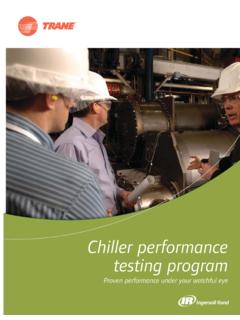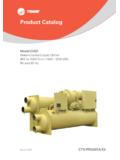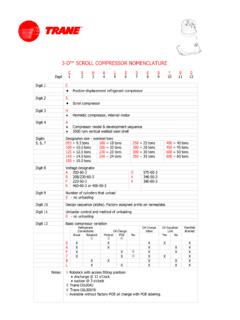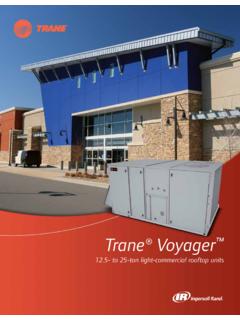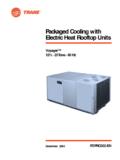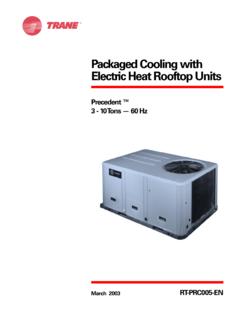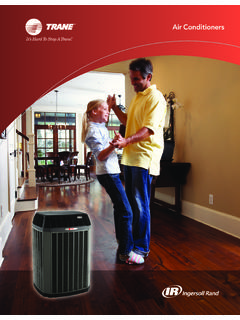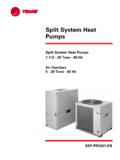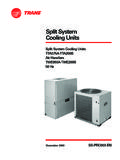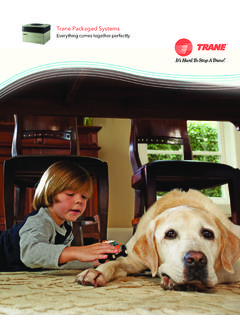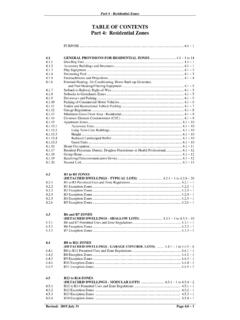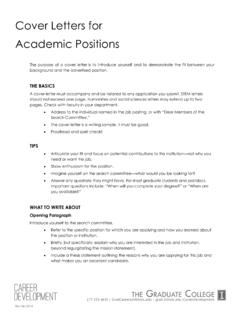Transcription of ASHRAE Standard 15 Applied to Packaged, Split and VRF …
1 Providing insights for today s hvac system designer 2008 trane . All rights reserved 1engineersvolume 37 1newsletterASHRAE Standard 15 Applied toPackaged, Split and VRF SystemsFrom the a previous newsletter, we discussed the application of ANSI/ ASHRAE Standard 15, "Safety Standard for Refrigeration Systems," to large chillers and the machinery rooms that house them. It's important to remember that Standard 15 applies to more than large chillers. In this Newsletter, we examine the requirements of Standard 15 as they apply to smaller refrigeration systems specifically, packaged units, Split systems, and the newer variable refrigerant flow (VRF) ANSI/ ASHRAE Standard 15 is widely recognized as the preeminent guide for the safe use of refrigeration equipment, as evidenced by its inclusion in model codes and state and local codes. Inclusion in these codes provides enforcement by the authority having jurisdiction (AHJ).
2 However, progression from ANSI/ ASHRAE Standard to state and local code can take several years and often changes portions of the original Standard (see "The Tortuous Path from ASHRAE Standard to State Code," Engineers Newsletter, volume 28-2). This process can result in slight variations in the enforced code from state to state, and sometimes even from city to city. For this reason, it's best to review both the local code and any standards that are referenced by the code when designing refrigeration systems. This newsletter reviews the application of the ASHRAE requirements for packaged , Split , and VRF systems in various applications using the current version ( Standard 15-2007) for reference. Very little has changed over the last few revision cycles of Standard 15 as Applied to these systems; however, Standard 15 relies on ANSI/ ASHRAE Standard 34 for refrigerant safety data, and recent changes to Standard 34 will impact the application of these systems.
3 Start at the Beginning. The first two sections of Standard 15 define the purpose and scope respectively as: "This Standard specifies safe design, construction, installation, and operation of refrigeration systems." (ANSI/ ASHRAE Standard 15-2007, Section 1) "This Standard establishes safeguards for life, limb, health, and property and prescribes safety requirements." (ANSI/ ASHRAE Standard 15-2007, Section )The scope of Standard 15 goes on to state that it covers all types of mechanical and absorption refrigeration equipment in the areas of design, construction, test, installation, operation, and inspection. With application to such a wide variety of equipment, ASHRAE Standard 15 has a broad range of requirements, although not all requirements apply to all types of equipment. Determining which requirements apply to a given system is accomplished using three basic sorting classifications: occupancy (Section 4), system (Section 5), and refrigerant (Section 6).
4 Occupancy classification divides buildings according to the ability of people to respond to a refrigerant-related emergency, and Section 4 defines six unique occupancy classifications. The same general requirements apply to all occupancies with the exception of industrial and institutional occupancies. An institutional occupancy is defined as a: "..premise or that portion of a premise from which, because they are disabled, debilitated, or confined, occupants can not readily leave without the assistance of others. Institutional occupancies include, among others, hospitals, nursing homes, asylums, and spaces containing locked cells." (ANSI/ ASHRAE Standard 15-2007, Section ) System classification divides refrigeration system types according to the potential of the refrigeration equipment to expose the occupants to refrigerant. A low probability system is one:".
5 In which the basic design, or location of the components, is such that leakage of refrigerant from a failed connection, seal, or component can not enter the occupied space." (ANSI/ ASHRAE Standard 15-2007, Section )Conversely a high probability system is one: ".. in which the basic design, or the location of components, is such that a leakage of refrigerant from a failed connection, seal, or component will enter the occupied space." (ANSI/ ASHRAE Standard 15-2007, Section )By this definition, any refrigeration system with a refrigerant containing component in the occupied space, or the airstream serving an occupied space, is considered a high probability system. 2 trane Engineers Newsletter volume 37 1providing insights for today s HVAC system designerRefrigerant classification is based on the safety of the refrigerant used. Standard 15 draws refrigerant safety classification from ANSI/ ASHRAE Standard 34, which classifies refrigerants by toxicity and flammability into one of six categories (see Figure 1).
6 All of the refrigerants shown in Figure 2 are Class A (lower toxicity) and Class 1 (no flame propagation). Standard 34 is also the source of the refrigerant quantity limits shown in Standard 15 and in Figure 2. See accompanying sidebar for more information on how recent changes in Standard 34 have changed both the rating system and the refrigerant quantity limits for each refrigerant. Where do we go from here? Once our application has been classified by occupancy, system, and refrigerant safety, we can reference Section 7, Figure 2. Refrigerant safety data from Table 1 of ASHRAE Standard 34-2007 Refrigerant numberSafety groupRCL lb/Mcf* Highly toxic or toxic under code *These values are included in the 2006 International Mechanical Code"Restrictions on Refrigerant Use," to determine which of the ANSI/ ASHRAE Standard 15 requirements must be followed to assure a safe installation: "The quantity of refrigerant in each independent circuit of high probability systems shall not exceed the amounts shown in Table 1, except as provided in and , based on volumes determined in accordance with " (ANSI/ ASHRAE Standard 15, Section )Section reduces the refrigerant quantity by 50 percent for institutional occupancies.
7 This additional restriction is required because the occupants can not leave the building quickly in the event of a refrigerant release. Section exempts industrial occupancies and refrigerated rooms from these limits, provided certain conditions are met. A3 Figure 1. ASHRAE Standard 34-2007 Safety Classifications1 Standard 15 defines a machinery room as ".. a space, meeting the requirements of Sections and , that is designed to house compressors and pressure vessels."Misinterpretations have been made regarding the ASHRAE toxicity-rating system. ASHRAE designates refrigerants as lower toxicity (Class A) or higher toxicity (Class B). Refrigerants designated as Class A are not non-toxic there are hazards associated with all refrigerants. In the past, the cardiac sensitization effect of a refrigerant was used to set the allowable quantity for occupied spaces for Class A refrigerants.
8 Threshold Limit Value-Time Weighted Average (TLV-TWA) was used to set the allowable limit for Class B refrigerants. Although this system has worked fairly well it did not consider many of the personnel escape-impairing effects of refrigerants. With the 2007 edition of Standard 34, ASHRAE changed to using refrigerant concentration limit (RCL) to determine the allowable pounds of refrigerant per 1000 cubic feet (lb/Mcf) of occupied space. RCL takes into consideration a variety of acute exposure criteria including cardiac sensitization, oxygen deprivation, flammability, and other escape-impairing effects. Essentially, the change to Standard 34 is a change to Standard 15. Note (a), on the column labeled "Quantity of Refrigerant per Occupied Space", in Table 1 of Standard 15 states:"The refrigerant safety groups in Ta b l e 1 a r e n o t p a r t o f A S H R A E Standard 15.
9 The classifications shown are from ASHRAE Standard 34, which governs in the event of a difference."The next revision of Standard 15 will include RCL values in Table 1; model and local codes are also making the change. Secondly, there has been some confusion about the correlation between ASHRAE Classes A and B (lower and higher toxicity) and the toxicity classifications used in the International Fire Code, the Uniform Fire Code, and by OSHA. These codes use a toxicity rating system that differs substantially from the ASHRAE rating system. To help clarify the difference in the two rating methods, the 2007 edition of ASHRAE Standard 34 has added a column to Table 1 titled "Highly Toxic or Toxicc under Code Classification". Note c states: "'Highly toxic,' 'toxic,' or 'neither,' where 'highly toxic' and 'toxic' are as defined in the International Fire Code, Uniform Fire Code, and OSHA regulations, and 'neither' identifies those refrigerants having lesser toxicity than either of those groups.
10 " All refrigerants listed in Figure 2 of this newsletter are identified as "neither." The purpose of the limits imposed by Section is to prevent the occupants of a building from being exposed to an unsafe concentration of refrigerant if a leak occurs. If a leak does occur, the resulting refrigerant concentration in the occupied space is dependent on the quantity of refrigerant in the equipment and the volume of space available for dilution. The concentration limits are listed both in terms of parts per million and pounds per 1000 cubic feet (lb/Mcf).Refrigerant concentration limits can not be exceeded in any occupied space. If the calculated concentration for the refrigerant being used exceeds the levels shown in ASHRAE Standard 15, Table 1 (or, for institutional occupancies, 50 percent of those concentrations), the system is not permitted. ASHRAE Standard 15 defines an occupied space as ".
